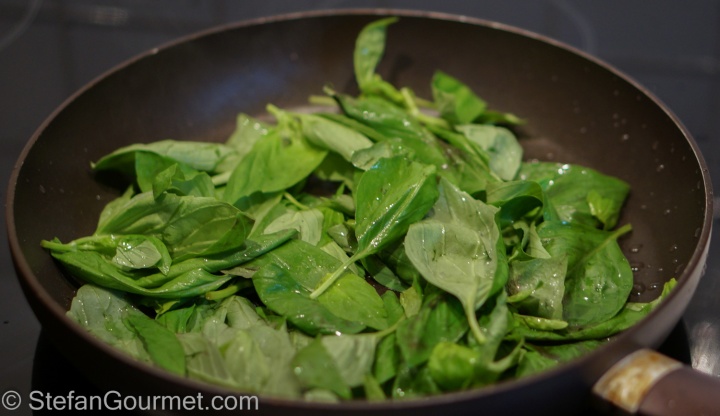
Sometimes I get a request from a reader that leads me to discovering a new dish. For instance malloreddus pasta with fennel and sausage, now one of my favorite pasta dishes. This time it was Himeros who requested my take on basil-ricotta gnudi. These are the Tuscan name for nude ravioli, or ravioli filling that are not surrounded by pasta. In other parts of (Northern) Italy they are simply called gnocchi (which means dumplings). One of the most common fillings for ravioli is spinach and ricotta, and the most common gnudi are also made from spinach and ricotta. These gnudi made with basil and ricotta were very nice indeed. Here’s what I did…
Ingredients

For about 40 gnudi (2 large or 4 small servings)
50 grams (1.8 oz) basil leaves
125 grams (1/2 cup) ricotta (homemade)
1 egg
60 grams (2.1 oz) freshly grated pecorino (preferably ‘toscano’) + more for serving
35 grams (1/4 cup) all-purpose flour (Italians would use 00 flour)
semolina flour for dusting the gnudi
salt
butter
lemon zest
Preparation

Wash the basil leaves. Reserve about 4 leaves. Put the rest of the leaves in a non-stick frying pan with the water that clings to the them.

‘Stir-fry’ over medium-high heat…

Put the basil on an old tea towel…

…and use it to squeeze the water out of it.

Combine the ricotta, egg, basil, and pecorino in a food processor…

…and process until the mixture is homogeneous.

Transfer to a bowl and add the flour.

Stir to incorporate the flour. The mixture should be quite sticky, but not too soft or wet. Add a bit more flour only if needed. (The less flour, the more ‘pillowy’ your gnudi are going to be.)

Cover with plastic wrap and refrigerate for an hour or so to firm up. This will make it easier to roll balls out of the mixture.

Fill a shallow wide container or a deep plate with a layer of semolina flour (about 3 mm or 1/8″ should do). Roll small balls out of the mixture using your hands, like rolling small meatballs. If your hands are not too warm and the mixture is cold enough, this should be quite easy but still a bit of the mixture may stick to your hands. Put the balls on the semolina flour and continue until you have filled up the space without crowding.

Now gently shake and tilt the container to make the gnudi roll around in the semolina flour.

Keep this up until they are completely coated with semolina flour.

Transfer the gnudi to a tray and repeat until you have used up all of the mixture.
For best results, the gnudi should be cooked soon to avoid them losing their round shape or sticking to the tray. Bring a large pot of water to a boil.

Melt some butter in a non-stick frying pan and then keep it warm over very low heat.

When the water boils, regulate the heat to a nice simmer (not a rolling boil). Add salt and the gnudi, and cook them until they rise to the surface. This will only take a couple of minutes.

As soon as they rise to the surface, transfer the gnudi to the melted butter with a slotted spoon.

Repeat until you have transferred all of the gnudi. Then gently toss and tilt the pan to coat the gnudi with melted butter on all sides.

Serve the gnudi on preheated plates. Spoon some more butter on them if you like, and garnish with freshly grated pecorino, a bit of lime zest (not too much), and the reserved basil leaves (cut as chiffonade).
Wine pairing
This asks for a crispy unoaked white, Italian of course.
Flashback

It is amazing how good the most simple dishes can be. The only thing you need for this is fresh salmon, farmed is fine, and a digital instant-read thermometer with a probe. The salmon is cooked to medium rare in the oven and will be so tender and succulent that you can eat it with a spoon.
You can serve the salmon with your preferred sides, fresh herbs, or sauce, but it’s good enough by itself. This recipe for simple succulent salmon is so easy that anyone can do it. Please give this a try, you will be amazed!



A superb recipe, Stefan. They looks absolutely delicious, though I expect my portion would be significantly larger 🙂
LikeLiked by 1 person
Thanks! I served it as a primo course in a 4-course Italian menu. As a full meal, you could probably eat the whole batch by yourself 🙂
LikeLike
Nice post … it has inspired me to a try a Chinese equivalent using Shu Mai or Jiaozi fillings in a ‘nude version’ 🙂
LikeLiked by 1 person
Great, I’m looking forward to your post 🙂
LikeLike
Very nice looking gnudi!
LikeLike
These look immense. I’m definitely making thme at some point.
LikeLike
Ottima ricetta, come sempre!
LikeLiked by 1 person
These look wonderful! Thank you for the careful details that make this a recipe I am looking forward to trying.
Did you consider that this was a better result than if you had just used the same filling in ravioli? I wondered if your guests expressed any preference.
LikeLiked by 1 person
Thanks, I’m glad you liked it!
I apologize for the delay in responding to this — I thought I already had, but it is clear that I did not.
I think this filling is so delicate that it works better when it’s ‘nude’. The pasta would ‘dilute’ the flavor. For spinach ravioli it would be the other way around: I prefer spinach ravioli to spinach gnudi, as the latter would taste too strongly of spinach.
By the way, if you were to make a ricotta-basil filling for ravioli, the flour should be left out. It is only included in the gnudi to bind the mixture so it doesn’t disintegrate when you cook them.
LikeLike